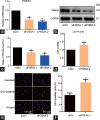Icariin targets PDE5A to regulate viability, DNA synthesis and DNA damage of spermatogonial stem cells and improves reproductive capacity
- PMID: 39774071
- PMCID: PMC12279358
- DOI: 10.4103/aja2024106
Icariin targets PDE5A to regulate viability, DNA synthesis and DNA damage of spermatogonial stem cells and improves reproductive capacity
Abstract
Icariin is a pure compound derived from Epimedium brevicornu Maxim, and it helps the regulation of male reproduction. Nevertheless, the role and underlying mechanisms of Icariin in mediating male germ cell development remain to be clarified. Here, we have demonstrated that Icariin promoted proliferation and DNA synthesis of mouse spermatogonial stem cells (SSCs). Furthermore, surface plasmon resonance iron (SPRi) and molecular docking (MOE) assays revealed that phosphodiesterase 5A (PDE5A) was an important target of Icariin in mouse SSCs. Mechanically, Icariin decreased the expression level of PDE5A. Interestingly, hydrogen peroxides (H 2 O 2 ) enhanced the expression level of phosphorylation H2A.X (p-H2A.X), whereas Icariin diminished the expression level of p-H2A.X and DNA damage caused by H 2 O 2 in mouse SSCs. Finally, our in vivo animal study indicated that Icariin protected male reproduction. Collectively, these results implicate that Icariin targets PDE5A to regulate mouse SSC viability and DNA damage and improves male reproductive capacity. This study thus sheds new insights into molecular mechanisms underlying the fate decisions of mammalian SSCs and offers a scientific basis for the clinical application of Icariin in male reproduction.
Keywords: DNA damage; Icariin; PDE5A; proliferation; spermatogonial stem cells.
Copyright ©The Author(s)(2025).
Conflict of interest statement
All authors declared no competing interests.
Figures






Similar articles
-
The antioxidant capacity and protective ability of astaxanthin in cryopreservation of mouse spermatogonial stem cells.Cryobiology. 2025 Sep;120:105261. doi: 10.1016/j.cryobiol.2025.105261. Epub 2025 Jun 5. Cryobiology. 2025. PMID: 40479954
-
Cnot3 is required for male germ cell development and spermatogonial stem cell maintenance.Development. 2025 Aug 1;152(15):dev204557. doi: 10.1242/dev.204557. Epub 2025 Aug 15. Development. 2025. PMID: 40814964 Free PMC article.
-
Gene regulation and signaling transduction in mediating the self-renewal, differentiation, and apoptosis of spermatogonial stem cells.Asian J Androl. 2025 Jan 1;27(1):4-12. doi: 10.4103/aja202464. Epub 2024 Aug 20. Asian J Androl. 2025. PMID: 39162186 Free PMC article. Review.
-
Expression profiling of stemness markers in testicular germline stem cells from neonatal and adult Swiss albino mice during their transdifferentiation in vitro.Stem Cell Res Ther. 2024 Apr 1;15(1):93. doi: 10.1186/s13287-024-03701-8. Stem Cell Res Ther. 2024. PMID: 38561834 Free PMC article.
-
Systemic pharmacological treatments for chronic plaque psoriasis: a network meta-analysis.Cochrane Database Syst Rev. 2021 Apr 19;4(4):CD011535. doi: 10.1002/14651858.CD011535.pub4. Cochrane Database Syst Rev. 2021. Update in: Cochrane Database Syst Rev. 2022 May 23;5:CD011535. doi: 10.1002/14651858.CD011535.pub5. PMID: 33871055 Free PMC article. Updated.
References
MeSH terms
Substances
LinkOut - more resources
Full Text Sources

